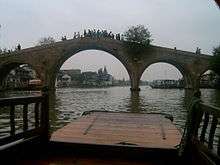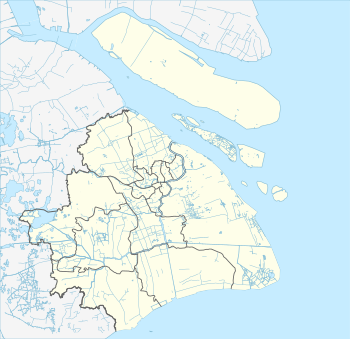Free Life Bridge
The Free Life Bridge (simplified Chinese: 放生桥; traditional Chinese: 放生橋; pinyin: Fàngshēng Qiáo) is a historic stone arch bridge over the Cao Port in Zhujiajiao, Qingpu District, Shanghai.[1]
Free Life Bridge 放生桥 | |
|---|---|
 Free Life Bridge in October 2011. | |
| Coordinates | 31°06′48.38″N 121°03′05.86″E |
| Crosses | Cao Port (漕港) |
| Locale | Zhujiajiao, Qingpu District, Shanghai |
| Other name(s) | Fangsheng Bridge |
| Characteristics | |
| Design | Arch Bridge |
| Material | Stone |
| Total length | 70.8 metres (232 ft) |
| Width | 5.8 metres (19 ft) |
| Height | 7.4 metres (24 ft) |
| History | |
| Constructed by | Xingchao (性潮) |
| Construction start | 1571 |
| Construction end | 1812 (reconstruction) |
| Opened | 1571 |
 Free Life Bridge Location in Shanghai | |
History
The bridge was originally built in 1571 with funds collected by monk Xingchao (Chinese: 性潮) from Cimen Temple (Chinese: 慈门寺). In the Ming and Qing dynasties (1368–1911), local monks would hold a ceremony on the bridge, releasing live fish into the port. It had been on the list of "The Ten Views of Zhujiajiao". It was rebuilt in 1812, in the ruling of Jiaqing Emperor (1796–1820) of the Qing dynasty (1644–1911).[2]
On November 17, 1987, it has been designated as a municipal level cultural heritage by the Shanghai Municipal Government.
Architecture
70.8-metre (232 ft) long and 5.8-metre (19 ft) wide, it is the largest stone bridge in Shanghai. It is of five-arch type. The bridge has a gentle slope as it adopts ultra-thin piers and arches with modest size changes, spanning naturally across the river, which looks majestic but not bulky. The stone carvings on the bridge are exquisite.[2]
References
- 寻访上海“中国特色小镇”朱家角 [Towns with Chinese Characteristics in Shanghai]. qq.com (in Chinese). 2018-02-27.
- Kang Guojian (2012), pp. 60–61.
Bibliography
- Kang Guojian, ed. (2012). "Zhujiajiao Town" 《朱家角镇》. 《古镇》 [Ancient Towns] (in English and Chinese). Hefei, Anhui: Huangshan Shushe. ISBN 978-7-5461-2712-5.CS1 maint: ref=harv (link)